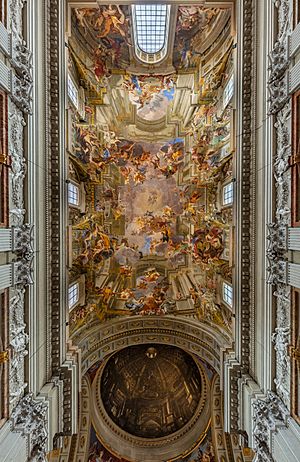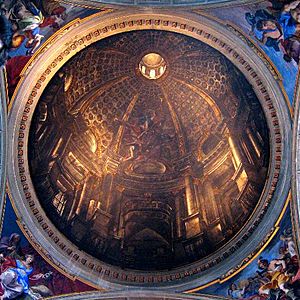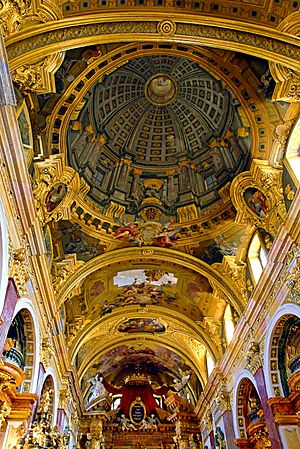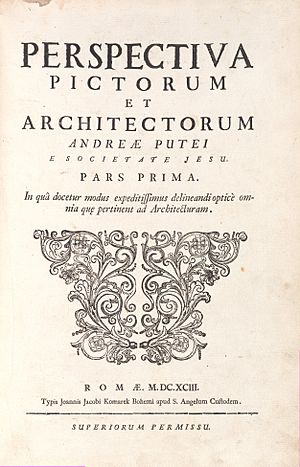Andrea Pozzo facts for kids
Quick facts for kids
Brother Andrea Pozzo, S.J.
|
|
|---|---|
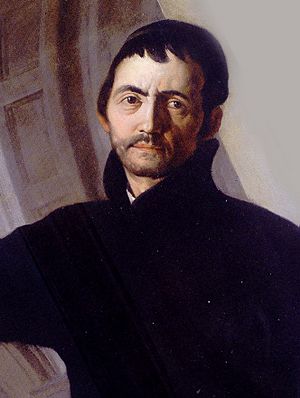
Self-portrait (17th century)
|
|
| Born | 30 November 1642 |
| Died | 31 August 1709 (aged 66) Vienna, Habsburg monarchy, Holy Roman Empire
|
| Nationality | Italian |
| Education | Palma il Giovane, Andrea Sacchi |
| Known for | Architecture, painting, decorator |
|
Notable work
|
|
Andrea Pozzo was a talented Italian artist who lived a long time ago (from 1642 to 1709). He was a Jesuit brother, which means he was part of a Catholic religious group. Pozzo was famous for many things: he was a painter, an architect, and a decorator. He even designed stages for plays!
He is best known for his amazing frescoes. These are paintings done on wet plaster walls or ceilings. Pozzo used a special trick called quadratura. This made flat surfaces look like they had deep, three-dimensional spaces. His most famous work is the ceiling of the Church of St. Ignatius in Rome. His art made him one of the most important artists of the Baroque period. He also designed buildings, like the Ljubljana Cathedral in Slovenia.
Contents
Biography
Early Life and Training
Andrea Pozzo was born in Trento, a city that was part of Austria at the time. He went to a Jesuit high school there. When he was 17, he started working with an artist to learn painting.
He probably learned from an artist linked to Palma il Giovane. After three years, he trained with another painter who taught him the style of Roman High Baroque art. He later traveled to other Italian cities like Como and Milan.
Becoming a Jesuit Artist
On December 25, 1665, Andrea Pozzo joined the Jesuit Order as a lay brother. This meant he was part of the religious order but not a priest. In 1668, he was sent to Milan. There, he created decorations for a festival honoring Francis Borgia, a Jesuit who had just become a saint. Everyone loved his work!
He continued to learn art in Genoa and Venice. His early paintings show the influence of artists from the Lombardy region. They used rich colors and strong contrasts between light and shadow. When he painted the Life of Jesus in Genoa, he was inspired by the famous artist Peter Paul Rubens.
Decorating Churches
The Jesuit Order needed many artists because they were building new churches. Pozzo often worked for them, decorating churches and other buildings. He painted in cities like Modena, Bologna, and Arezzo.
In 1676, he decorated the inside of the San Francis Xavier church in Mondovì. Here, you can see his early use of illusion. He painted fake gold, bronze-colored statues, and marble columns. He even painted a trompe-l'œil dome on a flat ceiling. This trick made the flat ceiling look like a tall, rounded dome. This was his first big fresco painting.
In Turin (1678), Pozzo painted the ceiling of the Jesuit church of SS. Martiri. Sadly, these paintings were damaged by water and later replaced. Only small parts of his original work remain.
Called to Rome
In 1681, the head of the Jesuits, Giovanni Paolo Oliva, asked Pozzo to come to Rome. Pozzo first worked as a stage designer for plays about the Bible. His amazing illusionistic paintings for these stages quickly made him famous. People saw him as a master of wall and ceiling decorations.
The Gesù Rooms
His first paintings in Rome were in a hallway connecting the Church of the Gesù to the rooms where St. Ignatius, the founder of the Jesuits, had lived. Pozzo's trompe-l'œil architecture and paintings of St. Ignatius's life blended perfectly with older paintings there.
The Church of St. Ignatius
Pozzo's most famous work is in the Jesuit church of Sant'Ignazio in Rome. Between 1685 and 1694, he painted the dome, the apse (the curved part behind the altar), and the ceiling. These paintings are a perfect example of the dramatic Baroque style in Rome.
Pozzo was incredibly skilled at creating illusions of depth. He used light, color, and painted architecture to make flat surfaces look like vast, open spaces. For many years, his work at Sant'Ignazio set the standard for ceiling frescoes across Catholic Europe.
The Church of Sant'Ignazio was not finished when it was dedicated in 1642. There were problems with the people who gave money for the church, so the planned dome was never built. Pozzo solved this by painting an illusion of a dome on a flat canvas. When you stand in the right spot, it looks like a real, tall dome!
On the flat ceiling, he painted a scene called the Apotheosis of S. Ignatius. This painting shows St. Ignatius being welcomed into heaven. It's 17 meters (about 56 feet) wide! If you stand on a special metal plate on the floor, the flat ceiling looks like a high, vaulted roof with statues. The painting celebrates the Jesuit missionaries who spread Roman Catholicism around the world.
Pozzo used clever tricks with perspective, light, and shadow. He made the church's barrel-vaulted nave (the main part of the church) look like an open hall leading to heaven. Light comes from God the Father, goes to Jesus, and then to St. Ignatius. From St. Ignatius, four rays of light spread out to the four continents. Pozzo said this showed Jesus's words: "I am come to send fire on the earth" and Ignatius's words: "Go and set everything aflame." Another ray of light shines on the name of Jesus. This amazing scene, with its deep perspective and swirling heavenly figures, was copied in many Jesuit churches in Europe.
The trompe-l'œil dome looks so real that it's hard to tell what is painted and what is actual architecture. Andrea Pozzo painted this dome on a canvas that was 17 meters wide. The paintings in the apse show scenes from the lives of St. Ignatius, St. Francis Xavier, and St. Francis Borgia.
St. Ignatius Chapel (Gesù)
In 1695, Pozzo won a competition to design an altar for the St. Ignatius chapel in the Church of the Gesù. This grand altar is above the saint's tomb. It features the Trinity (God the Father, Son, and Holy Spirit) and four columns made of lapis lazuli (a beautiful blue stone). These columns surround a huge statue of St. Ignatius by Pierre Legros. More than 100 sculptors and craftspeople worked together on this altar. Andrea Pozzo also designed the altar in the Chapel of St. Francesco Borgia in the same church.
Altars in St. Ignatius Church
In 1697, he was asked to build similar Baroque altars for the apse of the Sant'Ignazio church in Rome. These altars hold the relics (important historical remains) of St. Aloysius Gonzaga and St. John Berchmans.
Other Artworks
Pozzo continued painting frescoes and illusionistic domes in other cities like Turin, Mondovì, Modena, Montepulciano, and Arezzo. In 1681, the Grand Duke of Tuscany asked him to paint a self-portrait for his art collection. This painting is very unique. It shows Pozzo pointing to one of his illusionistic paintings, perhaps a trompe-l'œil dome. His other hand rests on three books, which might refer to his writings on perspective.
He also painted scenes from the life of St. Stanislaus Kostka in Rome. He painted the main altar painting of the Parish Church of Saint Michael in Brixen, which shows Michael fighting Lucifer. In 1699, he provided plans for the Jesuit college in Dubrovnik.
In 1702, Pozzo painted a dome on canvas for a church in Arezzo.
In Vienna
In 1694, Andrea Pozzo wrote a letter explaining his illusion techniques to Prince Anton Florian of Liechtenstein. The prince was the ambassador for Emperor Leopold I in Rome. Because of this recommendation, Emperor Leopold I invited Andrea Pozzo to Vienna in 1702 or 1703.
In Vienna, Pozzo worked for the emperor, the royal court, Prince Johann Adam von Liechtenstein, and various religious groups. He painted frescoes and a trompe-l'œil dome in the Jesuit Church. Some of his decorative works, like church and theater scenery, were temporary and no longer exist.
His most important work that still survives in Vienna is the huge ceiling fresco in the Hercules Hall of the Liechtenstein garden palace (1707). This painting, called Admittance of Hercules to Olympus, was greatly admired at the time. Using illusion, the painted architecture seems to extend from the ceiling, and the ceiling itself appears to open up to a heavenly world filled with Olympian gods.
Some of his altarpieces in Vienna's Jesuit church also remain. His designs for altarpieces and illusionistic ceiling frescoes greatly influenced Baroque art in Vienna. Many artists in Hungary, Bohemia, Moravia, Slovakia, and Poland followed his style.
Death
Pozzo died in Vienna in 1709. He had planned to return to Italy to design a new Jesuit church in Venice. He was buried with great honors in the Jesuit church in Vienna, one of his best works.
Writing and Architecture
Pozzo shared his artistic ideas in a famous book called Perspectiva pictorum et architectorum. It came out in two parts (1693 and 1698) and had 118 detailed drawings. In this book, he taught artists and architects how to paint architectural perspectives and stage designs.
This book was one of the first guides on perspective for artists. It was printed many times, even into the 1800s. Because of Pozzo's Jesuit connections, it was translated from Latin and Italian into many languages, including French, German, English, and Chinese.
Pozzo's book also included some of his architectural designs. These designs were not built at the time. However, his plan for the S. Apollinare church in Rome was later used for the Jesuit church of San Francesco Saverio (1700–1702) in Trento. Pozzo also designed the inside of this church.
Between 1701 and 1702, Pozzo designed two Jesuit churches in Montepulciano. These were the churches of San Bernardo and Chiesa del Gesù. However, his plans for the second church were only partly built.
See Also
 In Spanish: Andrea Pozzo para niños
In Spanish: Andrea Pozzo para niños
- Anamorphosis
- Quadratura
Images for kids


